Keeping bank statements is important. They help you track spending, spot errors, and understand your finances. These records are useful for tax purposes and loans. But how long should you keep bank statements? This is a common question. Many people save these documents, but they're not sure for how long. Knowing the right time to keep or throw them away is good.
This guide will help you. We will look at how long to keep bank statements. We'll explore reasons for holding onto them. Plus, we'll discuss when it's safe to eliminate them. Our goal is to make managing bank statements easy for you. This way, you can keep your financial records in order without stress. Let's dive into understanding the best practices for bank statement retention.
In this article
Part 1. The Standard Duration for Keeping Bank Statements

When it comes to bank statements, how long should you keep them? A good rule is to hold them for at least a year. This helps in managing your money and tracking your spending. For tax reasons, it's smart to keep them longer. The IRS can ask for records from the past three years. So, keeping bank statements for at least three years is wise.
But, sometimes, you need to keep them longer. If you file a loss from worthless securities or bad debt, keep statements for seven years. This is important for proving these losses on your taxes. A year's worth of statements is usually enough for day-to-day money management. These records help you see where your money goes. They also help in catching mistakes or fraud.
Each person's situation is different. Some might need to keep statements longer. Longer is better if you own a business, have loans, or are applying for a mortgage. In these cases, keeping statements for up to seven years is helpful. It shows your financial history and stability.
Also, think about how you keep these statements. Digital copies can save space and are easy to keep safe. Many banks offer online statements. You can download and store them on your computer. This is handy and saves paper.
You can keep bank statements for one to three years for personal finance. For tax purposes, three to seven years is best. Your needs might change based on your circumstances. Remember, these guidelines help in keeping your financial records in good shape. This way, you're ready for taxes, loans, or any money-related questions.
Part 2. Special Circumstances: When To Extend the Retention Period
Sometimes, you need to keep bank statements longer than usual. This is true in special cases.
For Properties
Keeping statements for more than a year is smart for big buys like a house or car. They prove you can afford these purchases. This is helpful when you need to show your financial health.
For Loans
If you're applying for a loan, longer retention is good. Banks often want to see your past money habits. They might ask for statements from the last few years. So, having them ready is important. It makes the loan process smoother.
For Business Purposes
In business, keeping statements for a long time helps. They can be needed for audits or tax queries. Businesses often keep financial records for up to seven years. This is to be safe and ready for any checks.
For Freelances
For those with irregular income, like freelancers, longer retention is wise. It shows your income over time. This is useful for taxes and when applying for credit.
How long should you keep your bank statements? The answer is as long as they are needed for your specific situation. Keeping them organized and safe is key. This way, you have them ready for when they're needed.
Part 3. PDFelement: Your Tool for Efficient Bank Statement Management

Managing bank statements can be easy with the right tool. PDFelement is a great choice. It helps you smartly handle your bank statements. With PDFelement, you can keep your statements in one place. This makes finding them simple.
What can PDFelement do? It lets you turn paper statements into digital files. You can scan your documents and save them as PDFs. This saves space and is more secure. You don't have to worry about losing papers. Plus, it's better for the environment.
With PDFelement, organizing your statements is a breeze. You can name and sort your files however you like. This makes looking for a specific statement quick and easy. You can even search for exact words in your statements. This is handy when you need to find something fast.
Another cool thing about PDFelement is how it keeps your files safe. You can set passwords for your documents. This means only you can open them. Your financial information stays private.
PDFelement is a great tool for managing your bank statements. It makes storing, finding, and protecting your financial records simple and efficient.
1. How To Combine Multiple Bank Statements Using PDFelement
Putting together many bank statements into one file is useful. You can do this easily with PDFelement. Here's a simple guide:
Step 1. First, start PDFelement on your computer.
Step 2. Next, look for the "Combine" option. You'll find it on the main screen when you open the program.

Step 3. Now, it's time to add your bank statements. You can drag them into the window that pops up. These can be PDFs, but also Word or Excel files.
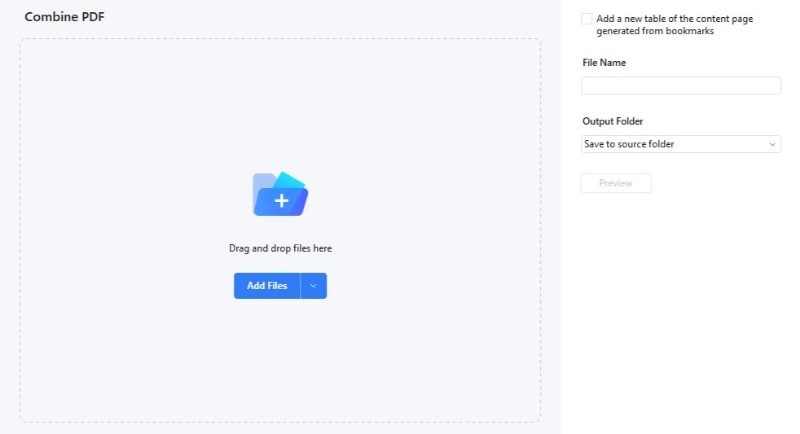
Step 4. Then, pick the pages you want to merge. For instance, you can choose if you want the first three pages from one statement and all pages from another.
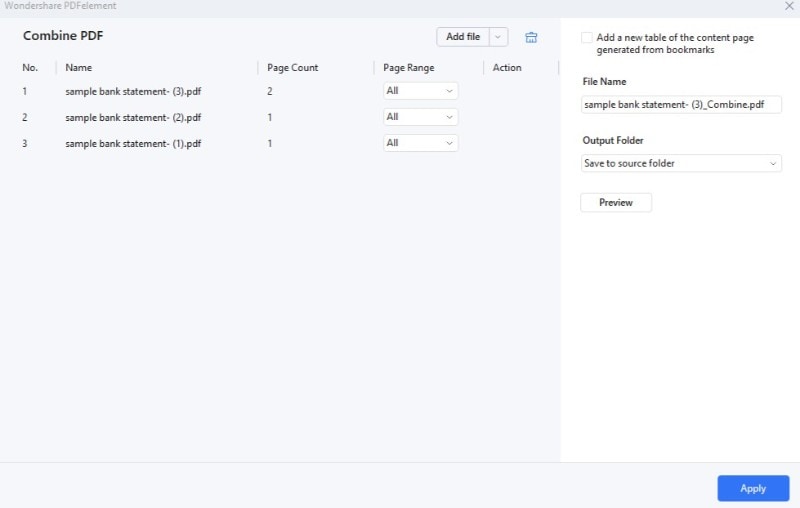
Step 5. Before you finish, you can check how it looks. Click 'Preview' to see the combined file.
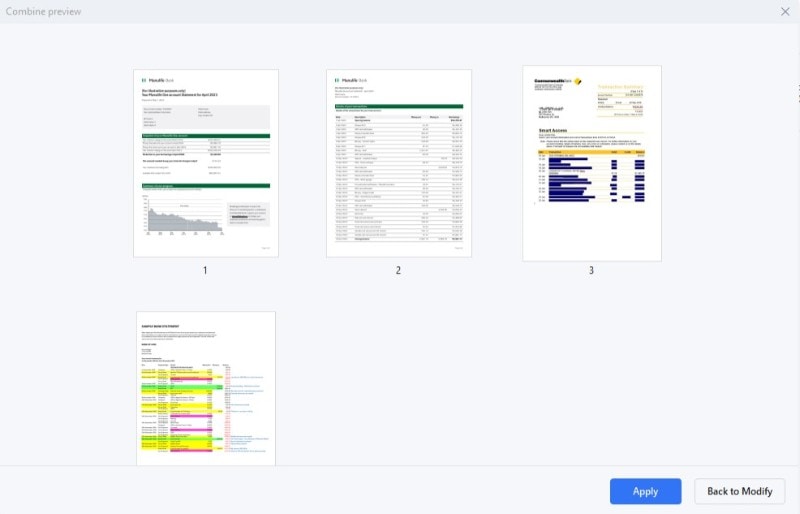
Step 6. If it looks good, click 'Apply.' This will put all your selected pages into one PDF file.
PDFelement is great because it can mix different types of files into one. This isn't just for PDFs.
So, managing your bank statements becomes much easier. This tool helps keep everything neat and in one place.
2. Compressing Your Combined Bank Statement Files
Making your PDF bank statements smaller in size is easy with PDFelement. Here's how to compress them:
Step 1. First, open PDFelement on your computer.
Step 2. On the main screen, you'll see options for compressing PDFs. You can click the 'Compress PDF' button. Or, find the compression tool in the 'Tool' section.

Step 3. Next, pick your PDF file. After that, you get to choose how much to shrink it. There are different levels of compression.
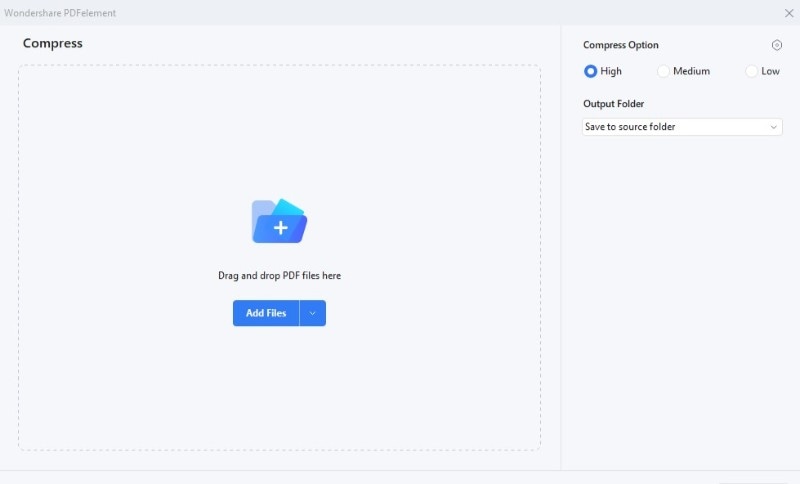
Step 4. Once you compress the file, see how much smaller it is. PDFelement will show you the size difference.
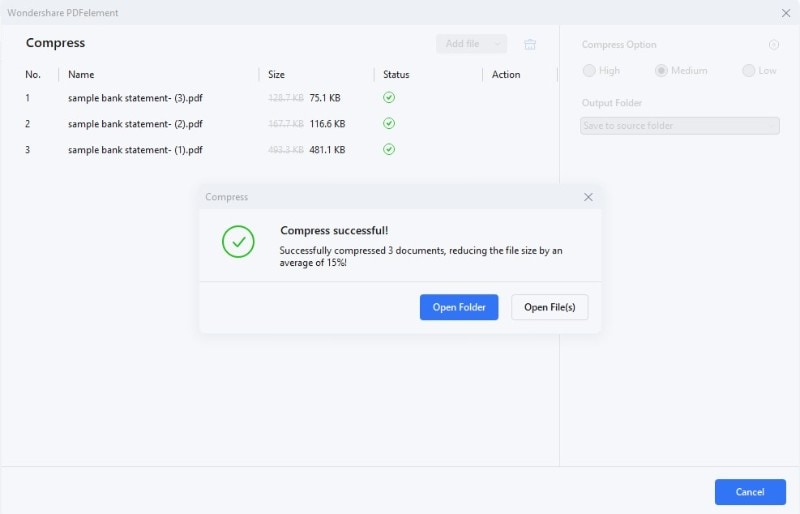
It's a good idea to check the quality of your compressed file. Use the preview option to see how it looks. You can return to the original size if the quality isn't great.
PDFelement doesn't just make files smaller. It also lets you edit and change them. You can add text or pictures. You can also make your documents safe and secure. It's a full package for handling your PDFs. This makes storing and sharing your bank statements more convenient.
3. Uploading Bank Statements to Wondershare Cloud for Anytime Access
Getting to your bank statements anytime is easy with Wondershare Cloud. Here's how to upload them:
Step 1. Choose the bank statements you want to upload. You can select files from your computer. Once you pick them, they're ready to go to the cloud.
Step 2.Click the upload button. This sends your statements to Wondershare Cloud. It's quick and simple.
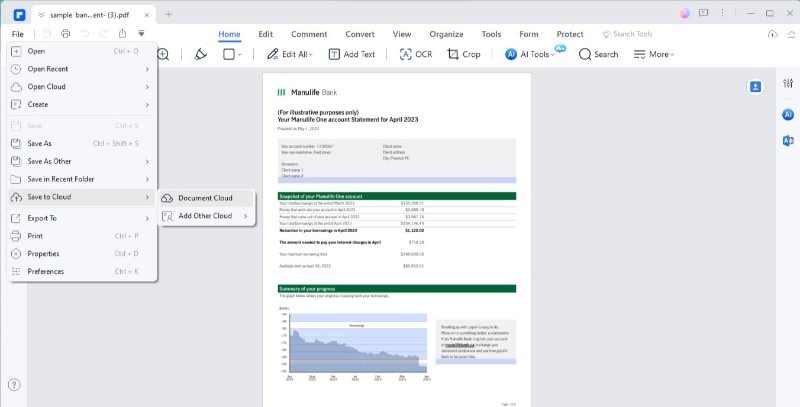
Step 3. After uploading, your files are in the cloud. This means you can get to them anywhere, anytime. You just need internet access.
Step 4. Check if your upload is successful. Go to your Wondershare Cloud account. There, you should see your bank statements.
With your statements in the cloud, you don't need to worry about losing them. They're safe and secure. You can access them from any device. This is great for when you're on the go.
Wondershare Cloud makes handling your financial documents easier. You have quick access and don't need to carry physical copies. It's a handy way to manage your bank statements.
Part 4. Best Practices for Storing Bank Statements
Storing bank statements well is key. Here are the best practices for both physical and digital storage:
Physical Storage
- Find a safe place, like a locked drawer or cabinet.
- Organize statements in folders, sorted by date.
- Keep them in a dry, cool area to prevent damage.
- Shred old statements; you don't need to keep private info safe.
Generally, you can keep them for at least one year. For important transactions, like home purchases, keep longer (up to seven years).
Digital Storage
- Use secure tools like PDFelement or cloud services.
- Make sure your computer has good security software.
- Back up files in different places (like an external hard drive).
- Name files clearly for easy searching.
Digital files can be kept longer because they don’t occupy physical space. Still, review and delete old files that are no longer needed.
Remember, for both types, check what you need for taxes or loans. Always protect your personal information, whether in paper or digital form.
Conclusion
Managing bank statements is crucial for financial health. Whether you keep paper or digital records, staying organized is key. Using tools like PDFelement makes this easier. It helps in combining, compressing, and securely storing statements. Remember, how long you keep them depends on your needs. With these tips, you can handle your financial documents smartly and safely.

 G2 Rating: 4.5/5 |
G2 Rating: 4.5/5 |  100% Secure
100% Secure



